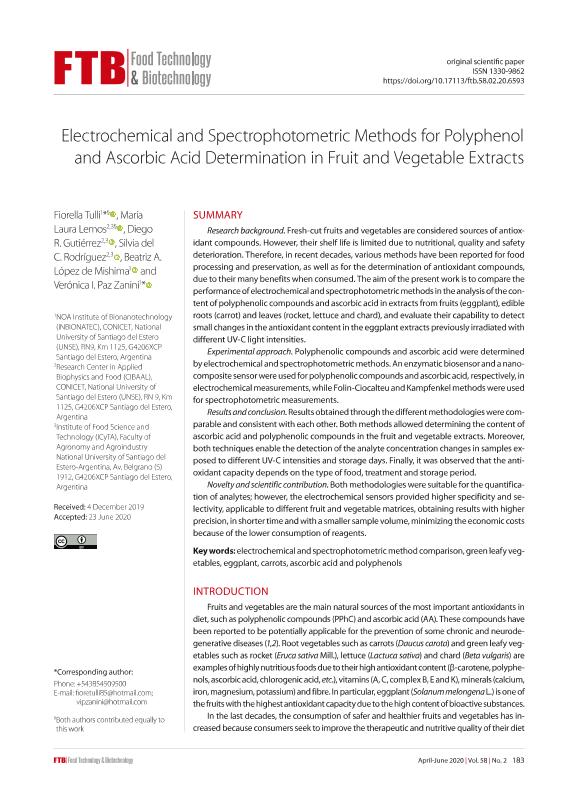Artículo
Electrochemical and spectrophotometric methods for polyphenol and ascorbic acid determination in fruit and vegetable extracts
Tulli, Fiorella Giovanna ; Lemos, Maria Laura
; Lemos, Maria Laura ; Gutierrez, Diego Ricardo
; Gutierrez, Diego Ricardo ; Rodriguez, Silvia del Carmen; Lopez, Beatriz Alicia
; Rodriguez, Silvia del Carmen; Lopez, Beatriz Alicia ; Paz Zanini, Veronica Irene
; Paz Zanini, Veronica Irene
 ; Lemos, Maria Laura
; Lemos, Maria Laura ; Gutierrez, Diego Ricardo
; Gutierrez, Diego Ricardo ; Rodriguez, Silvia del Carmen; Lopez, Beatriz Alicia
; Rodriguez, Silvia del Carmen; Lopez, Beatriz Alicia ; Paz Zanini, Veronica Irene
; Paz Zanini, Veronica Irene
Fecha de publicación:
04/2020
Editorial:
University of Zagreb. Faculty of Food Technology and Biotechnology
Revista:
Food Technology and Biotechnology
ISSN:
1330-9862
e-ISSN:
1334-2606
Idioma:
Inglés
Tipo de recurso:
Artículo publicado
Clasificación temática:
Resumen
Research background. Fresh-cut fruits and vegetables are considered sources of antioxidant compounds. However, their shelf life is limited due to nutritional, quality and safety deterioration. Therefore, in recent decades, various methods have been reported for food processing and preservation, as well as for the determination of antioxidant compounds, due to their many benefits when consumed. The aim of the present work is to compare the performance of electrochemical and spectrophotometric methods in the analysis of the content of polyphenolic compounds and ascorbic acid in extracts from fruits (eggplant), edible roots (carrot) and leaves (rocket, lettuce and chard), and evaluate their capability to detect small changes in the antioxidant content in the eggplant extracts previously irradiated with different UV-C light intensities. Experimental approach. Polyphenolic compounds and ascorbic acid were determined by electrochemical and spectrophotometric methods. An enzymatic biosensor and a nanocomposite sensor were used for polyphenolic compounds and ascorbic acid, respectively, in electrochemical measurements, while Folin-Ciocalteu and Kampfenkel methods were used for spectrophotometric measurements. Results and conclusion. Results obtained through the different methodologies were comparable and consistent with each other. Both methods allowed determining the content of ascorbic acid and polyphenolic compounds in the fruit and vegetable extracts. Moreover, both techniques enable the detection of the analyte concentration changes in samples exposed to different UV-C intensities and storage days. Finally, it was observed that the antioxidant capacity depends on the type of food, treatment and storage period. Novelty and scientific contribution. Both methodologies were suitable for the quantification of analytes; however, the electrochemical sensors provided higher specificity and selectivity, applicable to different fruit and vegetable matrices, obtaining results with higher precision, in shorter time and with a smaller sample volume, minimizing the economic costs because of the lower consumption of reagents.
Archivos asociados
Licencia
Identificadores
Colecciones
Articulos (CIBAAL)
Articulos de CENTRO DE INVESTIGACION EN BIOFISICA APLICADA Y ALIMENTOS
Articulos de CENTRO DE INVESTIGACION EN BIOFISICA APLICADA Y ALIMENTOS
Articulos(INBIONATEC)
Articulos de INSTITUTO DE BIONANOTECNOLOGIA DEL NOA
Articulos de INSTITUTO DE BIONANOTECNOLOGIA DEL NOA
Citación
Tulli, Fiorella Giovanna; Lemos, Maria Laura; Gutierrez, Diego Ricardo; Rodriguez, Silvia del Carmen; Lopez, Beatriz Alicia; et al.; Electrochemical and spectrophotometric methods for polyphenol and ascorbic acid determination in fruit and vegetable extracts; University of Zagreb. Faculty of Food Technology and Biotechnology; Food Technology and Biotechnology; 58; 2; 4-2020; 183-191
Compartir
Altmétricas



